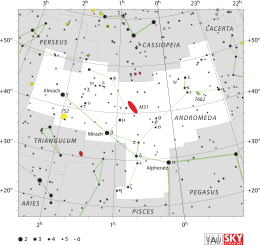Andromeda (constellation)
constellation in the northern celestial hemisphere
Andromeda is a constellation in the northern sky. It is named after the princess Andromeda in Greek mythology. It is sometimes called "Princess of Ethiopia" or "the Chained Woman" in English.[2] It has also been called Persea ("Perseus's wife")[2] or Cepheis ("Cepheus's daughter").[2] The astronomer named Ptolemy listed Andromeda when he made a list of 48 constellations. It is also one of the 88 constellations made by the International Astronomical Union.[3]
| Constellation | |
 | |
| Abbreviation | And |
|---|---|
| Genitive | Andromedae |
| Pronunciation | /ænˈdrɒmɨdə/, genitive /ænˈdrɒmɨdiː/ |
| Symbolism | Andromeda, the Woman Chained[1] |
| Right ascension | 1 |
| Declination | +40 |
| Quadrant | NQ1 |
| Area | 722 sq. deg. (19th) |
| Main stars | 4, 18 |
| Bayer/Flamsteed stars | 65 |
| Stars with planets | 8 |
| Stars brighter than 3.00m | 3 |
| Stars within 10.00 pc (32.62 ly) | 3 |
| Brightest star | α And (Alpheratz) (2.07m) |
| Messier objects | 3 |
| Meteor showers | Andromedids (Bielids) |
| Bordering constellations | Perseus Cassiopeia Lacerta Pegasus Pisces Triangulum |
| Visible at latitudes between +90° and −40°. Best visible at 21:00 (9 p.m.) during the month of November. | |

The Andromeda Galaxy is inside Andromeda. It is the closest spiral galaxy to Earth, at about 2.2 million light-years from Earth (estimates range up to 2.5 million light-years).[4] The brightest star in Andromeda is called Alpha Andromedae, which is a binary star.[5]
References
change- ↑ Allen (1899) p.31.
- ↑ 2.0 2.1 2.2 Allen (1899) pp.32, 33.
- ↑ Ridpath, Ian. "Chapter One continued". Star Tales. Retrieved 28 January 2013.
- ↑ Schoening, Bill; Harvey, Vanessa. "The Andromeda Galaxy". REU program/NOAO/AURA/NSF. Archived from the original on 22 November 2012. Retrieved 28 January 2013.
- ↑ Darling, David. "Alpheratz (Alpha Andromedae)". Retrieved 28 January 2013.